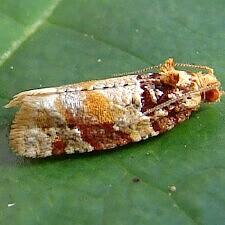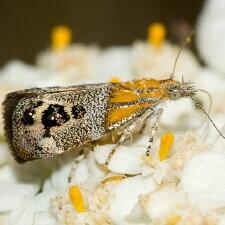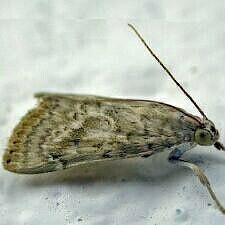New Photographs

3600 -- Argyrotaenia kimballi
Lake Co., FL - © Machele White

2644 -- Tebenna gemmalis
Stevenson, WA - © John Davis

4793 Alatuncusia bergii
St. Vincent and the Grenadines
© Mark de Silva

8461 -- Hypena humuli
Redwing, MN -- © Bill Johnson
Beads of Condensation in a Cave

8262 -- Ctenucha virginica
Berkeley, CA -- © Joyce Gross
|
Eighteen Months Have Flown By Since the last update of this page. It has been an extremely busy period trying to keep pace with your contributions of photographs. All 2007 photos should be posted to the Living Moths Plates Series before the end of the year. Those plates will soon hold more than 3,000 species represented by more than 9,000 of your photos. More than 6,600 species are now represented by spread specimen photos.
The Jim Vargo Collection has been completed with 4,700 photos of nearly 4,000 species. This magnificent donation to you and to MPG may be seen in its entirety from the Jim Vargo Plate Index. Some of Jim's left-wing photos remain to be added to that plate series. They should be in place by late this winter.
Matthew J. C. Barnes of Oxford, UK has given MPG permission to use photographs from his websites covering Belize, Jamaica, Nicaragua and St Vincent and the Grenadines. This permits us to fill in some missing species or upgrade spread specimen photos for a number of species that reach the southern limits of the United States.
Contributor's Pages: A new feature has been added just below the Main Menu option in the box at the upper left of all MPG pages. For spread specimens Contributor's Pages include coverage of the Geometridae (Bob Belmont), southwestern moths (Bob Nuelle, Jr.), Catocalas (John Peacock), Schinia (Mike Pogue and Chuck Harp), North American moths (Jim Vargo) and Papaipema (Jim Wiker).
Contributor's Pages for Living Moths will be limited. John Davis's Moths of the Pacific Northwest represents the first substantial contribution to MPG by a photographer in western North America and will be the nucleus for western plates to be added as soon as possible.
Mark de Silva's Moths of St. Vincent and the Grenadines combines living moths and spread specimens. Father Mark is a priest and naturalist who has published works on the fauna of the Grenadines and is currently working on several groups of insects. A surprisingly large percentage of his first 200+ species of moths are also to be found on the North American list, and more than 40 species that have been identified (some tentatively) are "firsts" for our living moth or spread specimen plates.
MPG "Model Websites". Two other collections are displayed in "MPG Model Format." Contributors to MPG who wish to begin their own websites (apart from MPG) may use this format (index page, fast browse plates and species pages) simply by downloading example pages and tailoring them to their own needs. Machele White's Moth's of Lake County, Florida is one of the "model" websites. The other is my own, Bob Patterson's Moths of Prince George's County, Maryland. If you need assistance to begin developing your own website in MPG format you may email me. Both of these model websites are still undergoing development.
Occasional Papers and Field Notes is another new feature (yet to be added to the menu blocks) for written papers and notes by MPG contributors. The first contribution comes from J. Mingari and Carroll Rudy on Hop Vine Moths, Hypena humuli, in a Wisconsin Cave. You are invited to submit illustrated articles or shorter notes for publication here. Studies in moth biology and "how-to" articles on rearing larvae, trapping or attracting equipment or photographic methods will be welcome. While contributions will not be subjected to a formal process of peer review, papers will be closely examined for style and accuracy and may be circulated for advice and comment by professional lepidopterists.
Welcome New Contributors:
David Anderson (OR), Peter Aron (CT), Roy Beckenmeyer (KS), Nick Block (IL), Jillian Cowles (AZ), Alan Cressler (GA), Penny Crispin (TX), Howell Curtis (IN), Sarah Dickey (CA), Patrick Dockens (AZ), Jim Durban (IA), Rebecca Durham (MT), John Ellison (AZ), Bill Evans (NY), John Fisher (OK), Andrew Gale (CA), Pete Ganzel (MN), Bill Garthe (IL), Valerie Gawenda (TX), Matt Goff (AK), Anita Gould (NJ), Donald Gudehus (OR), Jeff Hahn (MN), Ronald Hanson (BC), Eric Haley (FL), Doug Happ (NY), Jan Harding (AZ), Meena Haribal (NY), Diane Harper (FL), Kenneth Harrelson (IL), Gordon Harrison (ON), Jim Heustess (OK), Vincent Hickey (ME), Dona Hilkey (CO), Sam Houston (OK), Karyn Huenemann (BC), Jim & Susan Hunter (NM), Matt Ireland (MI), M. Alan Jenkins (OK), Kojun Kanda (AZ), Gary Kessler (NY), Mark Killion (IL), Harry King (NC), Ethan Kistler (OH), David Kleiman (ON), Michael Kleinbaum (OR), Kort Kramer (FL), Eric LaGasa (WA), Dan Lavin (TX), Anthony Magee (CO), Edda Martinez (MS), Don Martinson (WI), Kerry Matz (UT), John Meyer (NC), Rick Miller (NC), Graham Montgomery (TX), Arlon Motsch (TX), Tomas Mustelin (WA), Jennifer Forman Orth (MA), Ken Osborne (CA), Loren & Babs Padelford (NE), Janis Paseka (NE), Robert Pearson (AZ), Claude Pilon (QB), Michael Plagens (AZ), Nelson Poirier (NB), Dave Porter (FL), Matthew Priebe (CA), Lori Reynolds (IN), John Riutta (OR), Joe Rowlett (IA), Stephen Schueman (MD), Tom Shermer (BC), David Smith (LA), Doug Smith (VA), Jeff Smith (CA), Wanda Smith (TX), Pam Snyder (FL), Peter Sussmann (OR), Bill Taylor (NY), Edward Trammel (AR), Cat Traylor (TX), Ren Tumlison (AR), Zak Van Loocke (MI), Robyn Waayers (CA), Rich White (AZ), Ron Whte (NH), David Williams (WA), Sissy Willis (MA), Dick Wilson (WA), Kevin Wirth (WA), Hartmut Wisch (CA),
Got the Mothing Bug? Add your photographs to the collaborative effort here at Moth Photographers Group and help build the photobase that helps everyone interested in moth identification. Are You a Moth Specialist? Add an entry in your CV by refereeing a family or subfamily here, and help build the accuracy of the photo library.
Your Unidentified Moths: Send them in. Any number, 1 to 100 or more, just pick the best photo of each species that you can't identify. Once a photo has been identified it will move to the live moth archives where it can help others to identify their moths. See the Submit a Photo page.
|







